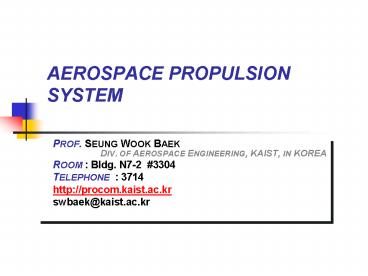AEROSPACE PROPULSION SYSTEM - PowerPoint PPT Presentation
1 / 16
Title:
AEROSPACE PROPULSION SYSTEM
Description:
Airbreathing engine (propeller, turpoprop, turbojet, turbofan, ... F=thrust which would be produced by the thrust generator if the external flow are isentropic ... – PowerPoint PPT presentation
Number of Views:1058
Avg rating:3.0/5.0
Title: AEROSPACE PROPULSION SYSTEM
1
AEROSPACE PROPULSION SYSTEM
- PROF. SEUNG WOOK BAEK
- DIV. OF AEROSPACE ENGINEERING, KAIST, IN KOREA
- ROOM Bldg. N7-2 3304
- TELEPHONE 3714
- http//procom.kaist.ac.kr
- swbaek_at_kaist.ac.kr
2
Propulsion devices
devices which produce thrust for acceleration and
overcome external drag by generating rearward
momentum in one or more streams of gas
Airbreathing engine (propeller, turpoprop,
turbojet, turbofan, ramjet, scramjet) fluid
stream entering and leaving the propulsion
device Rocket engine (liquid and solid) ejection
of stored mass (fueloxidizer)
PROPULSION AND COMBUSTION LABORATORY
3
Airbreathing engines
- release internal chemical energy combined with
external oxidizer - chemical -gt thermal -gt kinetic energy
- Engine components inlet, compressor (and fan),
- combustor, turbine, afterburner and nozzle
- Common performance measures
- a compromise among specific thrust, specific
impulse, thrust specific fuel consumption
PROPULSION AND COMBUSTION LABORATORY
4
Airbreathing engines
- Thermal efficiency a ratio of the rate of
kinetic energy generation to the rate of thermal
(chemical) energy input - Propulsive efficiency a ratio of the useful
power transmitted to the flight vehicle to the
rate of kinetic energy generation - Afterburning increases the specific thrust at
the high performance condition and allows use of
a more fuel-efficient system for subsonic
cruise.
PROPULSION AND COMBUSTION LABORATORY
5
Chemical rockets
- release internal chemical energy combined with
internal oxidizer - Solid propellant rockets
- -relative simplicity
- -weapon or strap-on booster rocket to very
- large orbiting rockets
- -increased propellant density with heavily
aluminized solid propellant-very small cross
section and reduced drag for low altitude
PROPULSION AND COMBUSTION LABORATORY
6
Chemical rockets
- Solid propellant rockets
- Design problem
- -thrust level variation and rapid thrust
termination - -screaming acoustic instability resilient
propellant material-optimal cross-sectinal
shapes that reduce wave reflection
PROPULSION AND COMBUSTION LABORATORY
7
Solid propellant rockets
- Double-base propellants
- -homogeneous propellant grain
- -nitrocellulose type of gunpowder dissolved in
nitroglycerin - -major ingredients are explosives and
contribute to the functions of fuel, oxidizer
and binder
PROPULSION AND COMBUSTION LABORATORY
8
Solid propellant rockets
- Composite propellants
- -heterogeneous propellant grain
- -oxidizer crystals and powdered fuel
(usually aluminum) held together in a matrix
of synthetic rubber binder - -less hazardous to manufacture and handle
than double-base propellants
PROPULSION AND COMBUSTION LABORATORY
9
Solid propellant rockets
- Composite double-base propellants
- -a combination of double-base and composite
propellants - -usually crystalline oxidizer (ammonium
perchlorate) and powdered aluminum fuel
held together in a matrix of nitrocellulose- nitro
glycerin
PROPULSION AND COMBUSTION LABORATORY
10
Chemical rockets
- Liquid propellant rockets
- -highly energetic liquid fuels and oxidizers in
low pressure tanks - -variable thrust level capability
- -pumps and associated piping lead to an
increase in size and overall mass of the
vehicle - Boiling points O2 -183 0C
- H2 -253 0C
- N2 -196 0C
PROPULSION AND COMBUSTION LABORATORY
11
Chemical rockets
- Liquid propellant rockets
- Design problem
- -turbo pumps to supply the necessary
fuel/oxidizer ratio - -variable nozzle to provide the maximum
possible thrust for each altitude(maximum
possible thrust occurs when the nozzle
exhaust pressure is very near the ambient
pressure - -base heating
PROPULSION AND COMBUSTION LABORATORY
12
Chemical rockets
- Liquid propellant rockets
- Design problem
- Instabilities
- -chugging-relatively low-frequency oscillation
when combustion chamber pressure variations
couple with the liquid fuel and oxidizer
supply system-raising the fuel and oxidizer
supply pressures-heavy piping and pump
equipment
PROPULSION AND COMBUSTION LABORATORY
13
Chemical rockets
- Liquid propellant rockets
- Design problem
- Instabilities
- -screaming-acoustic instability indentified with
the increase in the thermal output of fuel-
oxidizer - -increase in pressure and temperature in the
two phase region close to injector heads - -amplified to extreme levels by reflection form
chamber walls-acoustic tiling
PROPULSION AND COMBUSTION LABORATORY
14
Non-chemical rockets
- -required for very high energy missions for which
the vehicle velocity change is very large - -energy supplied to a propellant through the
thermal energy or radiative energy from a nuclear
reactor and solar concentrator - -nuclear heated rocket, electrical rocket and
etc.
PROPULSION AND COMBUSTION LABORATORY
15
Overall performance
- Thrust reaction to the net force that the engine
exerts on the fluid passing through it - Separate engine performance from effects of
enclosure or airframe - Fthrust which would be produced by the thrust
generator if the external flow are isentropic
PROPULSION AND COMBUSTION LABORATORY
16
Overall performance
- Determine F in terms of engine parameters
- Propulsive flow flow of the working fluid
- External flow flow of fluid surrounding the
thrust generator in a frame of reference fixed to
the thrust generator
PROPULSION AND COMBUSTION LABORATORY































